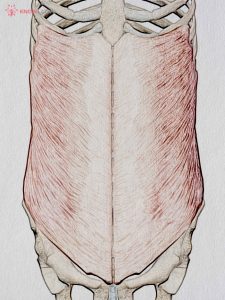The abdominal wall encloses the abdominal cavity and can be divided into anterolateral and posterior sections.
The abdominal wall forms a firm, yet flexible boundary which:
- Keeps the abdominal viscera in the abdominal cavity and assists the viscera in maintaining their anatomical position against gravity.
- Protects the abdominal viscera from injury.
- Assists in forceful expiration by pushing the abdominal viscera upwards.
- Is involved in any action (coughing, vomiting, defecation) that increases intra-abdominal pressure.
All these functions involve the action of the muscles and their correct functioning. The muscles of the abdominal wall are divided anatomically in two regions:
- Anterior – Anterolateral Abdominal Wall Muscles Anterior muscles are divided in 2 main groups: vertical muscles and flat muscles.
- Posterior Abdominal Wall Muscles The muscles that compose the posterior abdominal wall are powerful stabilizers of the lumbar spine and their disfunction is often involved in spine problems (together with anterior muscles).

